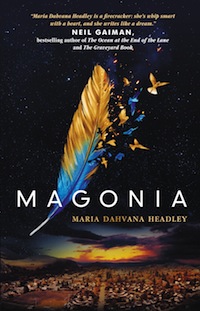Maria Dahvana Headley’s entry into YA fantasy is a strong, strong one. Magonia is the story of 16 year old Aza Ray Boyle, a girl who can not breathe the air of earth and has has been almost drowning in the atmosphere since shewas a baby.
Aza has always been different, always been unlike anyone else. ‘My history is hospitals’, she says at the very start of Magonia, describing her disease as something so unique that it is named after her, the only known carrier of Azaray Syndrome, with her tilted lungs and her strange heart. A miracle, the school nurse proclaims, and maybe she is, but mainly, Aza is just tired of being sick, tired of doctors not understanding her. ‘I’m dark matter’, she explains. ‘The universe inside of me is full of something, and science can’t even shine a light on it. I feel like I’m mostly made of mysteries’.
These mysteries are explored further when Aza stars to see visions of ships in the sky, and hears a voice calling down to her. Though her parents try to write this off as hallucinations caused by medication, Aza knows something strange is happening, especially when a huge flock of birds descends on the lawn outside her bedroom window and a feather is found in her lung.
A feather. In her lung! There’s something terribly tactile about that idea, something powerful and itchy and strange. That’s just the sort of book Magonia is—in fact, that’s just the sort of writer Headley is, with her wild, unique, gorgeous ideas of blue-hued sky people made flesh and leaping off the pages of Magonia. Because once Aza leaves the earth and ascends to the world of Magonia, with it’s vast sky ships, indentured labour bird-people, bat-sails, tiny totemic birds living in hearts, a ghost that is ‘old sadness with a loud voice’, the thrills and twists in this adventure never flag at all. It’s a well paced story, with Headley frequently introducing luxurious new images or developing a lush motif further, building on the fascinating European myth of Magonia, a cloud realm from which tempestarii or weather magicians created storms to descend and steal grain from the people of the land. Magonia, in real life, is also the botanical genus for a number species of flowering plants, many of them massive trees like the horse-chestnut and the neem. Not one to forget such details, Headley weaves the trees in to her story too, in an savvy ecologically aware move.
There is a moment in Magonia when Aza breaks free of her insecurities and the fear that has been holding her back. It is a moment when a young woman comes into herself, when she understands and knows who she is and more importantly, what she is capable of: ‘I’m everything they thought I was, and more’. It is a huge, deep gasp of a moment, a satisfying release that resonates for pages—and not just because it comes from a song. Oh yes, there’s singing in Magonia too, huge magnificent singing that acts as a catalyst, a creative power and a defence all in one.
‘With this song, I write over the place where the old Aza was. I’m not that person. I’m Aza. I’ scream a song, punk rock without a microphone, the kind that makes boulders fall from the heavens.
Transforming rain into rock.
Destroying all those that can hear it.
I’m avalanching the sky.’
Once in the world of Magonia, Aza finds out where she came from and who her people are—her tribe, as it were. It’s not all hugs and immediate love forever though—there’s plenty of intrigue, mystery and moral ambiguity within Aza’s newfound tribe, so she finds herself having to navigate existing power dynamics, a predetermined societal order and a very specific role laid out for her regardless of her own personal choices. ‘Living is a risk, Aza,’ she is told. ‘Heroes die young. Would you choose to be less than a hero? Here, the sky will light the fire for you. Our funerals are their sunsets.’
Aza herself is an immediately relatable protagonist: a smart, sarcastic, emotionally aware teenager who uses her smart, sarcastic personality to deal with her condition as best she can, whether it is the possibility of dying soon, or that of inheriting a dangerous legacy in a world she has just barely understood. The sarcasm in Aza’s voice works, though, not just because she has humour but because it is not relentless—she is not bitter. In fact, she’s charmingly hopeful, finding possibilities in things others may not marvel at. On seeing a video of a deep sea squid, she thinks ‘every time someone finds a new animal, or a new amazing thing on earth, it means we haven’t broken everything yet.’ Her best friend (and potential love interest) Jason is another deftly created character, with his fierce intelligence and his all too human anxieties. The Captain of the Magonian ship Aza finds herself on (with no spoilers about who she is), is the perfect, single minded ferocious warrior this story needs—even though not everyone agrees with her decisions. With shades of Grendel’s mother about her, she’s not someone who will be easily forgotten.
There is great hope in Magonia. There is sweeping beauty and pain and wonder, too. Headley’s worldbuilding is finely crafted, featuring a society that is just as complex as any we’ve known, though so much more colourful and innovative than any we’ve seen in recent YA. This a book that brings to mind specific moments from Diana Wynne Jones’ incredible Chrestomanci novels, moments that are so fiercely imaginative they take your breath away.
Magonia is available now from HarperCollins.
Mahvesh loves dystopian fiction & appropriately lives in Karachi, Pakistan. She writes about stories & interviews writers the Tor.com podcast Midnight in Karachi when not wasting much too much time on Twitter.










